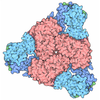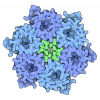[English] 日本語
 Yorodumi
Yorodumi- PDB-1j79: Molecular Structure of Dihydroorotase: A Paradigm for Catalysis T... -
+ Open data
Open data
- Basic information
Basic information
| Entry | Database: PDB / ID: 1j79 | ||||||
|---|---|---|---|---|---|---|---|
| Title | Molecular Structure of Dihydroorotase: A Paradigm for Catalysis Through the Use of a Binuclear Metal Center | ||||||
 Components Components | dihydroorotase | ||||||
 Keywords Keywords |  HYDROLASE / HYDROLASE /  TIM barrel / TIM barrel /  metalloenzyme / metalloenzyme /  pyrimidine biosynthesis pyrimidine biosynthesis | ||||||
| Function / homology |  Function and homology information Function and homology information dihydroorotase / pyrimidine nucleotide biosynthetic process / dihydroorotase / pyrimidine nucleotide biosynthetic process /  dihydroorotase activity / 'de novo' UMP biosynthetic process / 'de novo' pyrimidine nucleobase biosynthetic process / protein homodimerization activity / zinc ion binding / dihydroorotase activity / 'de novo' UMP biosynthetic process / 'de novo' pyrimidine nucleobase biosynthetic process / protein homodimerization activity / zinc ion binding /  cytosol / cytosol /  cytoplasm cytoplasmSimilarity search - Function | ||||||
| Biological species |   Escherichia coli (E. coli) Escherichia coli (E. coli) | ||||||
| Method |  X-RAY DIFFRACTION / X-RAY DIFFRACTION /  SYNCHROTRON / SYNCHROTRON /  MAD / Resolution: 1.7 Å MAD / Resolution: 1.7 Å | ||||||
 Authors Authors | Thoden, J.B. / Phillips Jr., G.N. / Neal, T.M. / Raushel, F.M. / Holden, H.M. | ||||||
 Citation Citation |  Journal: Biochemistry / Year: 2001 Journal: Biochemistry / Year: 2001Title: Molecular structure of dihydroorotase: a paradigm for catalysis through the use of a binuclear metal center. Authors: Thoden, J.B. / Phillips Jr., G.N. / Neal, T.M. / Raushel, F.M. / Holden, H.M. | ||||||
| History |
| ||||||
| Remark 999 | SEQUENCE Based on analysis of electron density, G69 has been modeled as a proline, I119 has been ...SEQUENCE Based on analysis of electron density, G69 has been modeled as a proline, I119 has been modeled as a valine, and N243 has been modeled as a glutamine. K102 is carboxylated. |
- Structure visualization
Structure visualization
| Structure viewer | Molecule:  Molmil Molmil Jmol/JSmol Jmol/JSmol |
|---|
- Downloads & links
Downloads & links
- Download
Download
| PDBx/mmCIF format |  1j79.cif.gz 1j79.cif.gz | 162.7 KB | Display |  PDBx/mmCIF format PDBx/mmCIF format |
|---|---|---|---|---|
| PDB format |  pdb1j79.ent.gz pdb1j79.ent.gz | 133.6 KB | Display |  PDB format PDB format |
| PDBx/mmJSON format |  1j79.json.gz 1j79.json.gz | Tree view |  PDBx/mmJSON format PDBx/mmJSON format | |
| Others |  Other downloads Other downloads |
-Validation report
| Arichive directory |  https://data.pdbj.org/pub/pdb/validation_reports/j7/1j79 https://data.pdbj.org/pub/pdb/validation_reports/j7/1j79 ftp://data.pdbj.org/pub/pdb/validation_reports/j7/1j79 ftp://data.pdbj.org/pub/pdb/validation_reports/j7/1j79 | HTTPS FTP |
|---|
-Related structure data
| Similar structure data |
|---|
- Links
Links
- Assembly
Assembly
| Deposited unit | 
| ||||||||
|---|---|---|---|---|---|---|---|---|---|
| 1 |
| ||||||||
| Unit cell |
| ||||||||
| Details | The biological assembly is a dimer composed of chains A & B which as deposited represent the actual dimer |
- Components
Components
| #1: Protein |  / dhoase / dhoaseMass: 38825.172 Da / Num. of mol.: 2 Source method: isolated from a genetically manipulated source Source: (gene. exp.)   Escherichia coli (E. coli) / Gene: PYRC / Production host: Escherichia coli (E. coli) / Gene: PYRC / Production host:   Escherichia coli (E. coli) / References: UniProt: P05020, Escherichia coli (E. coli) / References: UniProt: P05020,  dihydroorotase dihydroorotase#2: Chemical | ChemComp-ZN / #3: Chemical | ChemComp-ORO / |  Orotic acid Orotic acid#4: Chemical | #5: Water | ChemComp-HOH / |  Water Water |
|---|
-Experimental details
-Experiment
| Experiment | Method:  X-RAY DIFFRACTION / Number of used crystals: 1 X-RAY DIFFRACTION / Number of used crystals: 1 |
|---|
- Sample preparation
Sample preparation
| Crystal | Density Matthews: 2.36 Å3/Da / Density % sol: 47.86 % | ||||||||||||||||||||||||||||||||||||||||||||||||||||||||||||
|---|---|---|---|---|---|---|---|---|---|---|---|---|---|---|---|---|---|---|---|---|---|---|---|---|---|---|---|---|---|---|---|---|---|---|---|---|---|---|---|---|---|---|---|---|---|---|---|---|---|---|---|---|---|---|---|---|---|---|---|---|---|
Crystal grow | Temperature: 277 K / Method: macroseeding / batch / pH: 6 Details: PEG 3400, 2-(N-morpholino)ethanesulfonic acid (MES), potassium chloride, magnesium chloride, N-carbamoyl-DL-aspartate, pH 6.0, macroseeding / batch, temperature 277K | ||||||||||||||||||||||||||||||||||||||||||||||||||||||||||||
| Crystal grow | *PLUS Temperature: 4 ℃ / pH: 7 / Method: batch method / Details: used macroseeding | ||||||||||||||||||||||||||||||||||||||||||||||||||||||||||||
| Components of the solutions | *PLUS
|
-Data collection
| Diffraction | Mean temperature: 100 K | |||||||||||||||
|---|---|---|---|---|---|---|---|---|---|---|---|---|---|---|---|---|
| Diffraction source | Source:  SYNCHROTRON / Site: SYNCHROTRON / Site:  APS APS  / Beamline: 19-ID / Wavelength: 1.14020, 1.14050, 1.09045, 1.03320 / Beamline: 19-ID / Wavelength: 1.14020, 1.14050, 1.09045, 1.03320 | |||||||||||||||
| Detector | Type: CUSTOM-MADE / Detector: CCD / Date: Jul 7, 2000 | |||||||||||||||
| Radiation | Monochromator: SAGITALLY FOCUSED Si(111) / Protocol: MAD / Monochromatic (M) / Laue (L): M / Scattering type: x-ray | |||||||||||||||
| Radiation wavelength |
| |||||||||||||||
| Reflection | Resolution: 1.5→99 Å / Num. all: 114211 / Num. obs: 114211 / % possible obs: 97.7 % / Observed criterion σ(F): 0 / Observed criterion σ(I): 0 / Redundancy: 6.2 % / Rmerge(I) obs: 0.054 / Net I/σ(I): 41.1 | |||||||||||||||
| Reflection shell | Resolution: 1.5→1.55 Å / Redundancy: 3 % / Rmerge(I) obs: 0.247 / Mean I/σ(I) obs: 2.3 / Num. unique all: 10107 / % possible all: 87.5 | |||||||||||||||
| Reflection | *PLUS | |||||||||||||||
| Reflection shell | *PLUS % possible obs: 87.5 % / Num. unique obs: 10107 |
- Processing
Processing
| Software |
| |||||||||||||||||||||||||
|---|---|---|---|---|---|---|---|---|---|---|---|---|---|---|---|---|---|---|---|---|---|---|---|---|---|---|
| Refinement | Method to determine structure : :  MAD / Resolution: 1.7→30 Å / σ(F): 0 / σ(I): 0 / Stereochemistry target values: Engh & Huber MAD / Resolution: 1.7→30 Å / σ(F): 0 / σ(I): 0 / Stereochemistry target values: Engh & HuberDetails: Residue 317 of chain A has no density after the CB.
| |||||||||||||||||||||||||
| Refinement step | Cycle: LAST / Resolution: 1.7→30 Å
| |||||||||||||||||||||||||
| Refine LS restraints |
| |||||||||||||||||||||||||
| Software | *PLUS Name: TNT / Classification: refinement | |||||||||||||||||||||||||
| Refinement | *PLUS σ(F): 0 / % reflection Rfree: 10 % / Rfactor all : 0.193 : 0.193 | |||||||||||||||||||||||||
| Solvent computation | *PLUS | |||||||||||||||||||||||||
| Displacement parameters | *PLUS | |||||||||||||||||||||||||
| Refine LS restraints | *PLUS
|
 Movie
Movie Controller
Controller












 PDBj
PDBj








